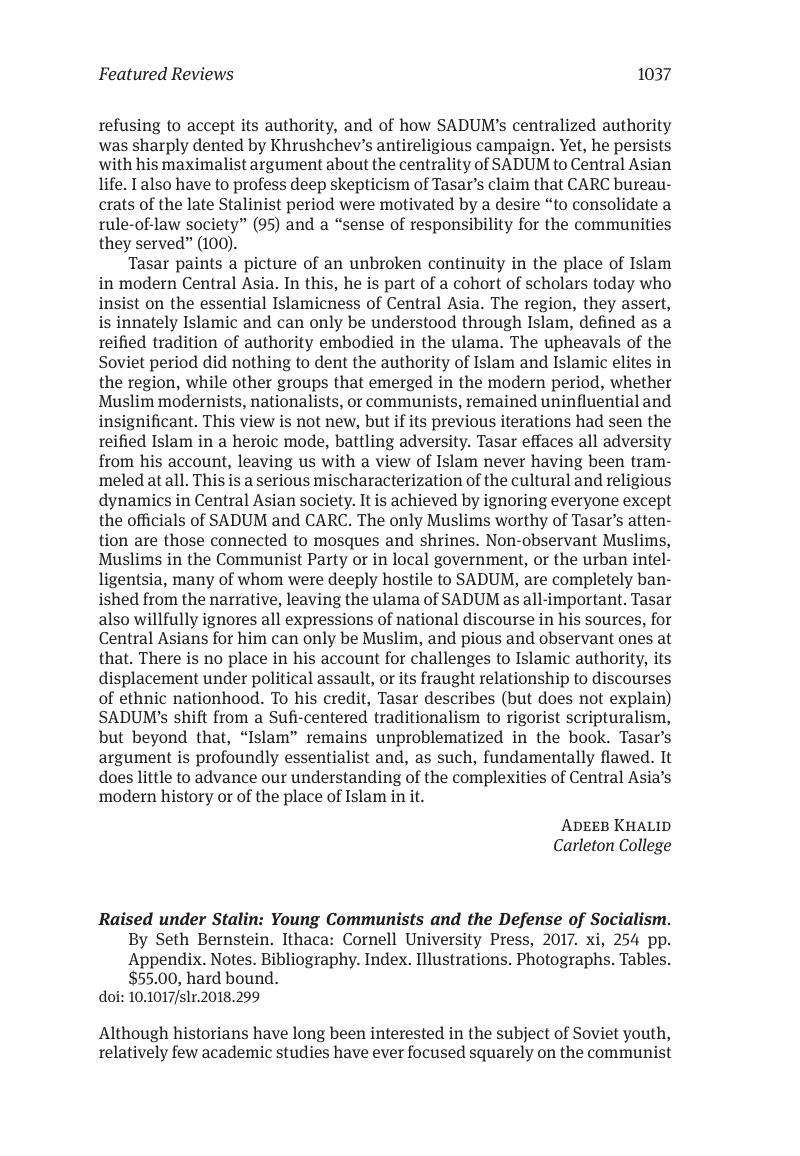No CrossRef data available.
Published online by Cambridge University Press: 12 February 2019

1. Most recent work on the Komsomol focuses on its first decade. See Neumann, Matthias, The Communist Youth League and the Transformation of the Soviet Union, 1918–1932 (New York, 2011)Google Scholar; Neumann, , “Revolutionizing Mind and Soul? Soviet Youth and Cultural Campaigns during the New Economic Policy, 1921–28,” Social History vol. 33, no. 3 (2008): 243–67CrossRefGoogle Scholar; Sean Guillory, “‘We Shall Refashion Life on Earth!’: The Political Culture of the Young Communist League, 1918–1928” (PhD. diss., University of California Los Angeles, 209); Guillory, , “The Shattered Self of Komsomol Civil War Memoirs,” Slavic Review vol. 71, no. 3 (Fall 2012): 546–65CrossRefGoogle Scholar. This is also true in regard to older work on the organization, including Tirado, Isabel, Young Guard! The Communist Youth League, Petrograd, 1917–1920 (New York, 1988)Google Scholar; Viola, Lynne, The Best Sons of the Fatherland: Workers in the Vanguard of Soviet Collectivization (New York, 1987)Google Scholar; Fischer, Ralph Talcot, Pattern for Soviet Youth: A Study of the Congresses of the Komsomol, 1918–1954 (New York, 1959)Google Scholar; Kassof, Allen, The Soviet Youth Program: Regimentation and Rebellion (Cambridge, 1965)CrossRefGoogle Scholar; Gooderham, Peter, “The Komsomol and Worker Youth: The Inculcation of ‘Communist Values’ in Leningrad during NEP,” Soviet Studies vol. 34, no. 4 (1982): 506–28CrossRefGoogle Scholar. For more general work on Soviet youth, see Kuhr-Korolev, Corinna, Plaggenborg, Stefam, and Wellmann, Monica, eds., Sowjetjugend 1917–1941: Generation zwischen Revolution und Resignation (Essen, 2001)Google Scholar; Derkachenko, Pitirim, ed., Molodezhnoe dvizhenie Rossii v dokumentakh 1905–1938 gg., (Moscow, 1999)Google Scholar; Hellbeck, Jochen, Revolution on My Mind: Writing a Diary Under Stalin (Cambridge, 2006)CrossRefGoogle Scholar; Halfin, Igal, From Darkness to Light: Class, Consciousness and Salvation in Revolutionary Russia (Pittsburgh, 2000)CrossRefGoogle Scholar; Halfin, , Stalinist Confessions: Messianism and Terror at the Leningrad Communist University (Pittsburgh, 2009)CrossRefGoogle Scholar; Gorsuch, Anne, Youth in Revolutionary Russia: Enthusiasts, Bohemians, Delinquents (Bloomington, 2000)Google Scholar; Konecny, Peter, Builders and Deserters: Students, State and Community in Leningrad, 1917–1941 (Montreal, 1999)Google Scholar; Husband, William, “Godless Communists”: Atheism and Society in Soviet Russia, 1917–1932 (DeKalb, 2000)Google Scholar; Nikonova, Ol΄ga, Vospitanie patriotov: Osoaviakhimi voennaia podgotovka naseleniia v Ural΄skoi provintsii (1927–1941 gg.) (Moscow, 2010Google Scholar.
2. Bernstein’s approach thus differs from the more “bottom-up,” grassroots perspective afforded by studies such as Neumann, The Communist Youth League and the Transformation of the Soviet Union, 1918–1932.
3. Much of this grassroots material is deliberately drawn from outlying regions and the non-Russian republics, at times based on archival research conducted outside of Moscow. It is presented anecdotally, much like Sheila Fitzpatrick does in her epic studies of the 1930s, rather than in the form of more systematic case studies. Such an approach offers considerable breadth, but at the cost of both depth and a better sense of regional variation and change over time. See Fitzpatrick, Sheila, Stalin’s Peasants: Resistance and Survival in the Russian Village after Collectivization (New York, 1996)Google Scholar; and Everyday Stalinism: Ordinary Life in Extraordinary Times: Soviet Russia in the 1930s (New York, 2000).
4. Anna Krylova, “Soviet Modernity in Life and Fiction: The Generation of the ‘New Soviet Person’ in the 1930s” (Ph.D. dissertation, Johns Hopkins University, 2000).
5. See, for instance, his address to the 10th Komsomol congress: A. Kosarev, “Bespredel΄no liubit΄ nashu rodinu,” Komsomol’skaia pravda, October 21, 1934, 3.
6. On Kosarev, see Trushchenko, N. V., Kosarev (Moscow, 1988)Google Scholar; Aleksandr Kosarev: sbornik vospominanii, second ed. (Moscow, 2003).
7. In attributing Kosarev’s fate to his institutional ties, Bernstein discounts post-Stalin rumors that regarded his fall to be the result of a personal vendetta. According to materials assembled in 1954 that led to Kosarev’s eventual rehabilitation, he had denounced L. P. Beriia while the latter was still secretary of the Transcaucasian party organization in the mid-1930s. When Beriia became NKVD chief in November 1938, he apparently took a personal interest in Kosarev’s arrest and then ordered him to be beaten into confessing to counterrevolutionary crimes. See Rossiiskii gosudarstvennyi arkhiv sotsial’no-politicheskoi istorii (RGASPI), f. 17, op. 171, d. 439, ll. 134–140. Such a simplistic account likely underestimates the degree to which Kosarev was already thoroughly compromised by the time of Beriia’s promotion.